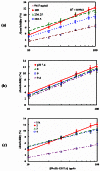Using Monoclonal Antibody to Determine Lead Ions with a Localized Surface Plasmon Resonance Fiber-optic Biosensor
- PMID: 27879723
- PMCID: PMC3681130
- DOI: 10.3390/s8010582
Using Monoclonal Antibody to Determine Lead Ions with a Localized Surface Plasmon Resonance Fiber-optic Biosensor
Abstract
A novel reflection-based localized surface plasmon resonance (LSPR) fiber-optic probe has been developed to determine the heavy metal lead ion concentration. Monoclonal antibody as the detecting probe containing massive amino groups to capture Pb(II)-chelate complexes was immobilized onto gold nanoparticle-modified optical fiber (NMAuOF). The optimal immobilizing conditions of monoclonal antibody on to the NMAuOF are 189 μg/mL in pH7.4 PBS for 2 h at 25°C. The absorbability of the functionalized NMAuOF sensor increases to 12.2 % upon changing the Pb(II)-EDTA level from 10 to 100 ppb with a detection limit of 0.27 ppb. The sensor retains 92.7 % of its original activity and gives reproducible results after storage in 5% D-( )-Trehalose dehydrate solution at 4°C for 35 days. In conclusion, the monoclonal antibody-functionalized NMAuOF sensor shows a promising result for determining the concentration of Pb(II) with high sensitivity.
Keywords: biosensor; gold nanoparticle; lead-chelate complex; lead-chelate complex. antibody; localized surface plasmon resonance; monoclonal antibody.
Figures







Similar articles
-
Detection of cadmium by a fiber-optic biosensor based on localized surface plasmon resonance.Biosens Bioelectron. 2009 Jan 1;24(5):1213-8. doi: 10.1016/j.bios.2008.07.013. Epub 2008 Jul 18. Biosens Bioelectron. 2009. PMID: 18718753
-
A label-free lead(II) ion sensor based on surface plasmon resonance and DNAzyme-gold nanoparticle conjugates.Anal Bioanal Chem. 2020 Nov;412(27):7525-7533. doi: 10.1007/s00216-020-02887-z. Epub 2020 Aug 23. Anal Bioanal Chem. 2020. PMID: 32829439
-
High-performance biosensor using a sandwich assay via antibody-conjugated gold nanoparticles and fiber-optic localized surface plasmon resonance.Anal Chim Acta. 2022 Jun 22;1213:339960. doi: 10.1016/j.aca.2022.339960. Epub 2022 May 20. Anal Chim Acta. 2022. PMID: 35641064
-
Fiber Optic Surface Plasmon Resonance-Based Biosensor Technique: Fabrication, Advancement, and Application.Crit Rev Anal Chem. 2016 May 3;46(3):213-23. doi: 10.1080/10408347.2015.1045119. Crit Rev Anal Chem. 2016. PMID: 27119268 Review.
-
Fiber-Optic Localized Surface Plasmon Resonance Sensors Based on Nanomaterials.Sensors (Basel). 2021 Jan 26;21(3):819. doi: 10.3390/s21030819. Sensors (Basel). 2021. PMID: 33530416 Free PMC article. Review.
Cited by
-
Electrochemical microsensors for the detection of cadmium(II) and lead(II) ions in plants.Sensors (Basel). 2010;10(6):5308-28. doi: 10.3390/s100605308. Epub 2010 May 27. Sensors (Basel). 2010. PMID: 22219663 Free PMC article.
-
Localized surface plasmon resonance shift of biosynthesized and functionalized quasi-spherical gold nanoparticle systems.RSC Adv. 2023 Aug 14;13(35):24211-24227. doi: 10.1039/d3ra04092e. eCollection 2023 Aug 11. RSC Adv. 2023. PMID: 37583667 Free PMC article.
-
Detection of hydrofluoric acid by a SiO2 sol-gel coating fiber-optic probe based on reflection-based localized surface plasmon resonance.Sensors (Basel). 2011;11(2):1907-23. doi: 10.3390/s110201907. Epub 2011 Feb 1. Sensors (Basel). 2011. PMID: 22319388 Free PMC article.
-
A Novel Aptamer-Imprinted Polymer-Based Electrochemical Biosensor for the Detection of Lead in Aquatic Products.Molecules. 2022 Dec 26;28(1):196. doi: 10.3390/molecules28010196. Molecules. 2022. PMID: 36615388 Free PMC article.
-
Emerging use of nanostructure films containing capped gold nanoparticles in biosensors.Nanotechnol Sci Appl. 2010 Dec 6;3:171-88. doi: 10.2147/NSA.S8981. Nanotechnol Sci Appl. 2010. PMID: 24198481 Free PMC article. Review.
References
-
- Tong S. Lead exposure and cognitive development: persistence and a dynamic pattern. J. Pediatr. Child Health. 1998;34:114–118. - PubMed
-
- CDC, Surveillance for elevated blood lead levels among children-United States, 1997-2001. Centers for Disease Control and Prevention MMWR Morb Mortal Wkly Rep. 2003;53:1–21. - PubMed
-
- Rothenberg S.J., Poblano A., Schnaas L. Brainstem auditory evoked response at five years and prenatal and postnatal blood lead. Neurotoxicol Teratol. 2000;22:503–510. - PubMed
-
- Anderson J.L., Bowden E.F., Pickup P.G. Dynamic electrochemistry: Methodology and application. Anal. Chem. 1996;68:379R–444R. - PubMed
Publication types
LinkOut - more resources
Full Text Sources

